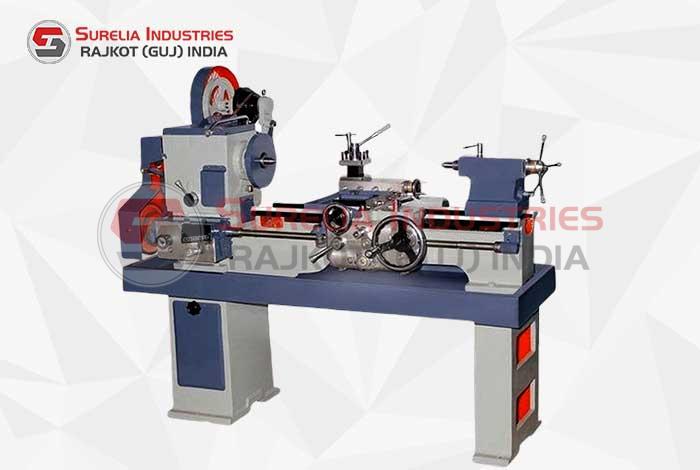
A light duty lathe machine is designed for small-scale operations in workshops and tool rooms. Using a light-duty lathe in the workshop, one may simply turn, drill, groove, shape, cut, knurl, and make threads on tougher metal or wooden surfaces.
Typically developed for small-scale companies and workshops, this is a compact machine tool that allows for efficient storage without taking up much space at work. A multifunctional lathe machine can make exact final products from hard metal, plastic, and wood surfaces which makes it the greatest solution for small-scale enterprises with limited space.
Let’s have a look at some of the most crucial elements and uses of a light duty lathe machine.
Bed, headstock, tailstock, saddle, lead screw, tool rest, countershaft, top slide, cross slide, chuck, and gears are some of the most important components of a light-duty lathe.
Tailstock: A light-duty lathe drill with a drilling tool carried in its tailstock. The tail stock features a handle that may be utilized to efficiently penetrate the drilling tool into the workpiece and execute a drilling operation.
Bed: The bed is the bottom component of the lathe machine that serves as the machine’s foundation support and is where all of the other pieces are installed.
Chuck: The workpiece is put on the base and secured using the chuck. The chuck rotates the workpiece, while the headstock permits the spindle to revolve at various rates. The tailstock contains the drilling tool, while the carriage houses the cross slide, top slide, and saddle, all of which are vital sections of the machine that contribute to an effective operation based on the user’s needs.
Threading and grooving are some of the operations performed with a light duty lathe machine in a workshop. The threading procedure involves inserting the tool into the workpiece. To complete the process, the lead screws are connected to the drive mechanism via gear trains, which are then joined to a carriage assembly.
Grooving is done using a grooving tool feed perpendicular to the rotating workpiece, the edges of the item can be silted or chopped to allow for an effective chamfering operation with a drilling tool.
What is a light duty lathe machine used for?
For experts in machining and manufacturing, the lathe machine is a multi-purpose instrument that is utilized for many activities including as
Turning
A lathe machine’s principal function is to rotate a workpiece while removing material with a cutting tool to make cylindrical forms. This procedure is critical in the manufacture of shafts, cylinders, and other components with circular cross-sections.
Facing
Lathe machines may cut flat surfaces at right angles to their axis of rotation. Typically, this method is used to create smooth, exactly vertical surfaces on workpieces.
Drilling:
Lathes can use drill bits, although their accuracy is worse than that of specialist machines. This capability is useful for creating holes in cylindrical workpieces or when pre-machining is required before further processing.
Boring
The aim of boring heads installed on lathe spindles equipped with cutting tools is to expand and improve existing holes in workpieces. When it comes to exact dimensions and surface polish requirements, this equipment will deliver excellent results.
Threading
Threaded items such as bolts, screws, and nuts can be produced using light duty lathe machines that create threads on cylindrical surfaces. It becomes critical when you require mating pieces for secure joining during assembly procedures.
Taper turning
Taper turning refers to machining techniques that produce conical forms or tapering surfaces. This operation might be performed on lathe machines using taper-turning attachments or by altering the tool position relative to the workpiece.
Knurling
Knurling is the process of putting textures onto cylindrical surfaces to improve grip or make them more appealing. Lathe machines with knurling capabilities push or roll knurls against the items they hold down.
Parting
Parting involves separating final goods from the residual raw material. As a result, employing part of the tool headstock provides for a more efficient manufacturing process.
Grooving
Lathe machines may create grooves, slots, and other recessed features on cylindrical or conical surfaces. Keyways, oil channels, and any other functional feature required on machined components must be constructed in this manner.
What are the different types of lathe machines?
There are various varieties of light duty lathe machines available to machining specialists, each with its own set of features and specifications. Some of the most common types of lathe machines are:
Centre Lathe (engine lathe)
The most common form of lathe machine is the center lathe, sometimes known as the engine lathe. It features a horizontal bed and holds the workpiece between centers or in a chuck.
Speed Lathe
Speed lathes are simple, lightweight devices used for light-duty turning activities. These light duty lathe machines have fixed headstocks and belt-driven spindles. Speed lathes are used for small-scale tinkering operations like as polishing and grinding.
Engine Lathe
Engine lathes are sturdy machines that can perform a variety of general-purpose turning operations. They are equipped with different spindle speeds, feed rates, and tooling choices which allow them to perform a wide range of machining tasks in production or maintenance facilities.
Tool Room Lathe
They feature tighter tolerances, strong frames, and higher-quality parts. Toolroom lathes are used in tool and die fabrication, prototype machining, and production.
Turret Lathe
These lathes have a turret tooling system and contain many cutting tools that allow for rapid tool changes and enhance production levels. This makes them adept at mass manufacturing tiny to medium-sized components through repeated machining procedures.
Conclusion
Lathe machines are quite sophisticated, but they also provide several advantages. You should always look for trusted brands of lathe machines for your industrial requirements. Surelia Industries is one of the top Light Duty Lathe Machine Manufacturers in India and offers custom products at the best price range.